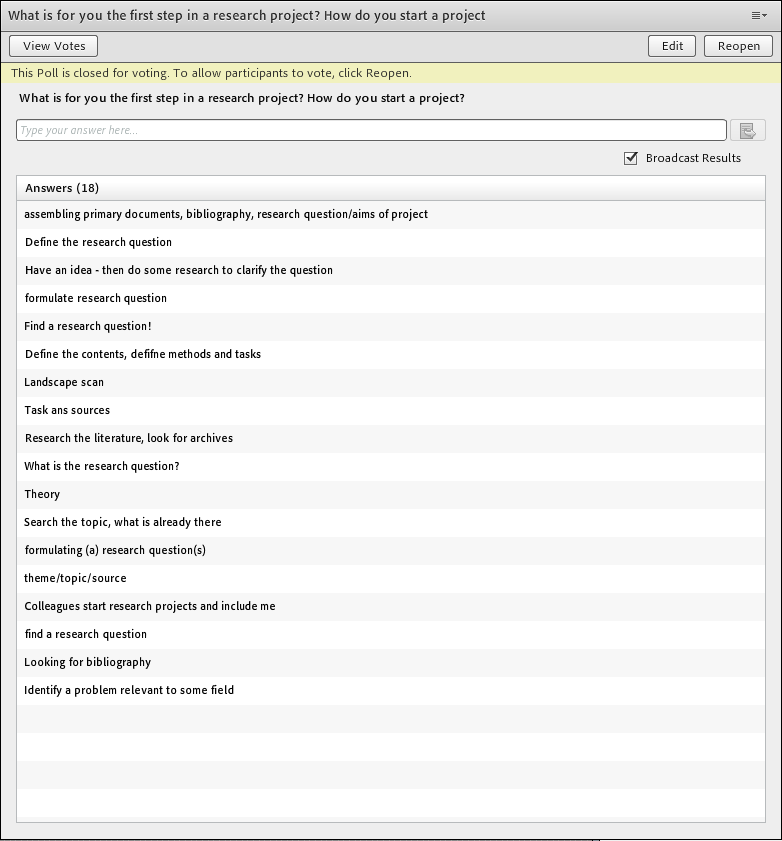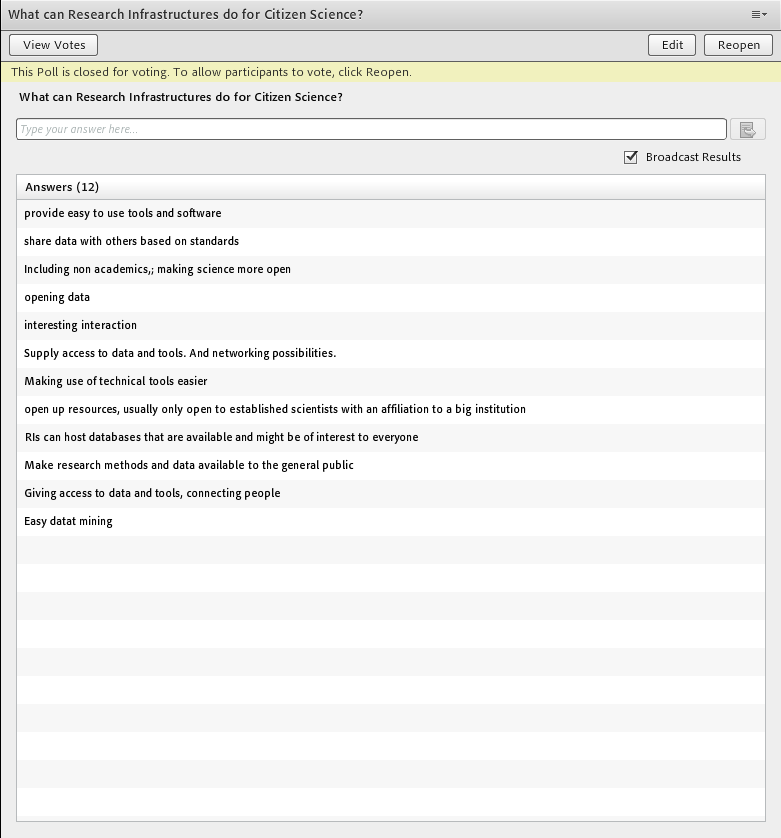Wrap Up & Materials of PARTHENOS eHumanities and eHeritage Webinar Series Webinar: Boost your eHumanities and eHeritage research with Research Infrastructures
written by Ulrike Wuttke, Darja Fišer (18.06.2018)
Trainers: Darja Fišer (University of Ljubljana), Ulrike Wuttke (University of Applied Sciences Potsdam), Moderator: Ulrike Wuttke (University of Applied Sciences Potsdam),
Date and Time: Thursday, 24.04.2018, 01:00 – 02:00 P.M. CEST
Materials
- View the slide set on SlideShare (PDF).
- Download the slide set from HAL (PDF).
- Download the slide set from Zenodo (PPTX).
- Watch the webinar recording on the PARTHENOS YouTube Channel.
- Watch the interactive webinar recording via Adobe Connect.
Wrap Up
This PARTHENOS webinar was dedicated to developing research questions, especially taking into account specific details of developing research questions with Research Infrastructures such as finding, working with and contributing data to research infrastructure collections, using Virtual Research Environments (VREs), and tools (Read the full description of this webinar). The webinar attracted participants from all over Europe (even as far as Perm, Russia) and one participant from Cameroon, Africa. This time the webinar was scheduled too late for our friends in the U.S. and Australia to join in. Darja and Ulrike discussed the topic insightfully from several perspectives and showed successful examples of how Digital Humanities and eHeritage approaches, in cooperation with relevant research infrastructures, have led to innovative research methods and questions.
After a short general introduction in which the trainers outlined the subject and the aims of the webinar, Darja used a poll to gain insight into the question of how the participants start their research projects (see Results Poll 1). The participants answered that their most common starting points are digging into related work, looking around what is out there already (literature and data), and trying to formulate a research question or that they are invited by colleagues to join research projects.

Results Poll 1: First step in a research project
Darja first addressed the question what developing a research question means in the (digital) humanities. On the example of the Gesta Danorum she showed how you can use quite simple tools to explore large corpora of texts in order to reveal interesting phenomena that can be developed into serious research questions. She underlined that nowadays research often does not need to start with digitizing data anymore, but with finding collections that already exist and can be used. The collections can be found through the CLARIN Resource families or the CLARIN Virtual Language Observatory, for example. Through these examples she explained how research infrastructures can be helpful indeveloping research questions in the humanities but also how researchers can find, work, and contribute data to research infrastructures, using Virtual Research Environments (VREs) and other tools (such as WebAnno, a web-based general-purpose annotation tool). For more general information about the existing research infrastructures (e.g. CESSDA, CLARIN, DARIAH, E-RIHS, ESS, SHARE) in the humanities and heritage science check the PARTHENOS webinar with Stefan Schmunk and Steven Krauwer and our PARTHENOS Module Introduction to Research Infrastructures.
One of the problems with the humanities data (especially cultural heritage data) is often that the re-use conditions (access, licence) are unclear. To overcome this obstacle, an initiative called the “Cultural Heritage Data Reuse Charter” was launched by several European infrastructures (including PARTHENOS) and other CH stakeholders. Its aim is, as Ulrike explained, to open up Cultural Heritage data where possible and to improve the interplay between scientific research and CHI (cultural heritage institutions) (Read more about Managing Cultural Heritage Assets in the Training Suite Module Manage, Improve and Open Up Your Research and Data). After this Darja and Ulrike presented several European humanities projects to illustrate some of the broad variety of digital approaches (Talk of Europe, A Digital Database of Manuscripts and Intercultural Dialogue in Post-Conquest England, The Janes Project, and the Venice Time Machine Project).
The last part of the webinar was dedicated to aspects of citizen science in the humanities research. Ulrike elaborated on the concept of citizen engagement in research in the perspective of Open Science and Open Innovation and underlined that citizen science aims at opening up research processes to actors outside academia and when taken seriously exceeds simple crowd sourcing of research tasks (Check also the PARTHENOS Training Suite module about Open Science). She concluded with a few examples (such as Letters of 1916, ARTigo, Citizen Science @ Libraries) and a summary of potentials and challenges of citizen science. At the end of this part Ulrike used a poll to ask the participants about their ideas what research infrastructures can do for citizen science (see Results Poll 2). One trend among the participants was general advice to make research infrastructures more inclusive for citizen scientists.

Results Poll 2: What can Research Infrastructures do for Citizen Science
Darja and Ulrike ended with the following takeaway messages:
- check first if data and tools you could use are already available
- start with a pilot to test your approach and then go big
- think and develop your research with open science in mind from the start
- citizen science have a high potential to prove the value of the humanities to the society: get creative and don’t be afraid
- for a citizen science project you need to think everything through from beginning: citizen science is not an afterthought
- acknowledge the need for upskilling of researchers and citizen scientists
- digital citizen science projects to ensure that applications are suited to the project and that data collection and data use conform to data protection laws
Last but not least: Collaborate! Get technical expertise/support from experts and research infrastructures.
Darja Fišer is currently developing with PARTHENOS Training a new module for the Training Suite around Developing Research Questions in an Infrastructural way that we hope to launch later this year.
Summary of the Question & Answer Session
After Darja and Ulrike had given their presentation the participants were invited to submit their question to the webinar trainers who answered them live. Most of the questions had already been answered during the webinar, however, there was one quite intriguing question about Citizen Science and Artificial Intelligence.
Question: Lekseikones was wondering if not AI (artificial intelligence) could replace citizens in some tasks? I’m sceptic if citizen science exists today more to make people engage and not because of the necessity of it. Ulrike answered that AI definitely has some potentials some take up work intensive tasks, but that citizen science is more than having citizens doing some work intensive tasks, as the first of all the engagement plays a huge role and some tasks cannot be done by machines (as the example of the ARTigo project shows where human intelligence is needed to correctly recognise art). At the moment still machines have to learn from humans, and we should take care what we teach them!
Image Credits:
Featured Image: “Boost your eHumanities and eHeritage research with Research Infrastructures”, Background pictures: Pictures clockwise :
https://upload.wikimedia.org/wikipedia/commons/1/17/Headline_of_the_New_York_Times_June-29-1914.jpg CC0
https://pxhere.com/de/photo/1163578 CC0
https://de.wikipedia.org/wiki/Wikipedia:Wien/Archiv/2015#/media/File:20140415_TFM_Edit-a-thon_Wien_0301.jpg CC BY-SA 3.0 at
https://de.wikipedia.org/wiki/Pariser_Manuskripte_(Leonardo_da_Vinci)#/media/File:Paris_Manuscript_F_Fol_18v19r.jpg CC0

